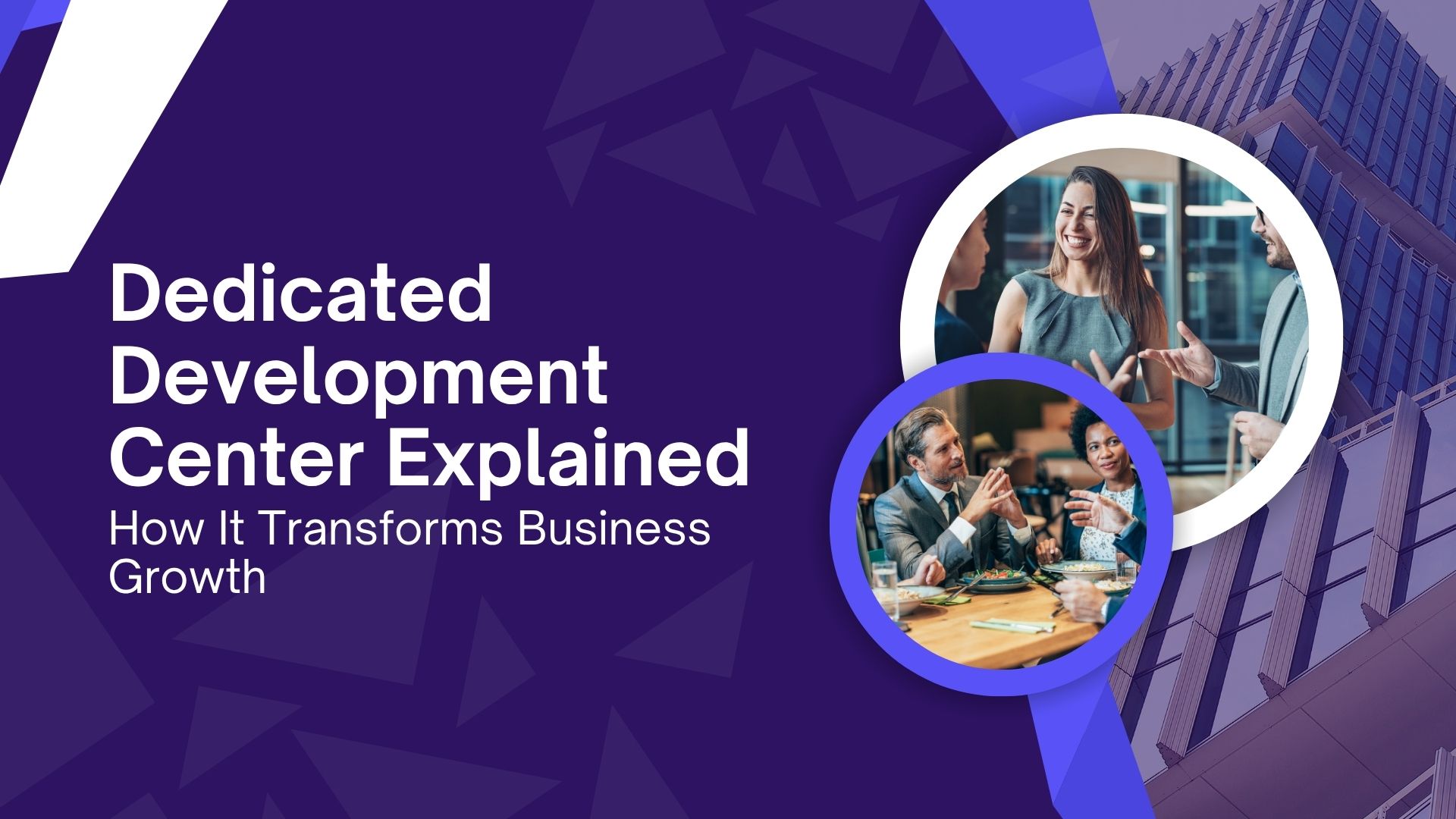Dedicated Development Center Explained: How It Transforms Business Growth

In today’s hyper-competitive world, technology decisions often determine how fast a business can grow. Many companies want to scale quickly but face challenges in finding skilled developers, especially when local hiring is expensive and time-consuming. According to Statista, the global IT outsourcing market is expected to surpass $512 billion by 2025. A growing share of this comes from the dedicated development center (DDC) model—a setup that balances cost efficiency with greater control over projects.
To put it simply, a dedicated development center allows a business to build a remote extension of its in-house team, managed by a partner but working exclusively for them. It’s not a faceless outsourcing model. Instead, it’s about long-term collaboration, ownership, and access to global expertise.
Let’s walk through what this model means in practice, why companies of all sizes are adopting it, and how it can transform business growth.
What a Dedicated Development Center Really Means
Imagine you’re running a growing eCommerce platform in the U.S. You need developers to build advanced recommendation systems, but hiring locally could take months and cost a fortune. A dedicated development center provides a different path.
Instead of setting up a new office overseas by yourself, you partner with a service provider who assembles a skilled team for you in another country. The developers work exclusively for your company, follow your processes, and use your tools. The difference is that infrastructure, recruitment, and administrative overhead are managed by the partner.
So, while traditional outsourcing often spreads a vendor’s team across multiple clients, a DDC acts as your team, just located elsewhere.
Why Companies Choose the DDC Model
Different organizations arrive at the DDC decision for different reasons, but a few themes stand out.
- Cost pressures: Building a tech team in regions like North America or Western Europe often strains budgets. With a DDC in Asia or Eastern Europe, companies lower costs without compromising skill levels.
- Talent shortages: Skilled developers, especially in areas like AI, IoT, or cloud, are not always available locally. A DDC bridges this gap.
- Scalability needs: Startups may begin with a small team but need the ability to grow quickly. Dedicated centers allow that flexibility.
- Faster execution: Recruitment handled by a partner means projects kick off sooner.
Take the example of a fintech company in London. They wanted to develop a blockchain-based payment platform. Instead of waiting six months to hire locally, they partnered with a DDC in Poland. Within eight weeks, they had a team of blockchain specialists working full-time on their project.
How a Dedicated Development Center Works Day-to-Day
The beauty of a DDC lies in how closely it mirrors an in-house setup. Here’s how it usually unfolds:
- Defining requirements: The client clarifies the kind of talent they need—backend engineers, data scientists, QA specialists, or designers.
- Recruitment and onboarding: The vendor recruits professionals who match those requirements, and the client interviews final candidates for fit.
- Integration: The new team adopts the client’s communication tools (Slack, Jira, GitHub) and development practices.
- Ongoing collaboration: The developers work exclusively for the client, reporting progress in daily stand-ups and sprint reviews, just like an in-house team.
In practice, the DDC feels like an offshore branch office—except the client doesn’t have to worry about payroll, office space, or IT support.
Dedicated Development Center vs. Other Options
Businesses often compare a DDC with other hiring models before deciding. To illustrate, let’s revisit the retail company from earlier.
- If they built an in-house team locally, they’d have full control but at a much higher cost.
- If they chose project-based outsourcing, they’d save money but would have less control, since the vendor would juggle multiple clients.
- With a DDC, they found the sweet spot—exclusive focus, manageable costs, and the ability to scale the team as their platform grew.
This balance between control and efficiency explains why DDCs are becoming the preferred model for many organizations.
How a DDC Transforms Business Growth
A dedicated development center is not just a way to save money. Its true value lies in how it impacts growth over time.
Reducing Costs Without Sacrificing Quality
A startup building an AI-driven SaaS product in California might pay $150,000 per developer annually. With a DDC in India, the cost could drop by 40–50%, without lowering expertise. The savings can be reinvested in marketing, product expansion, or customer acquisition.
Accessing Specialized Knowledge
Technologies evolve quickly. One month it’s machine learning, the next it’s generative AI. With a DDC, businesses can add experts in these areas without navigating local talent shortages.
Speeding Up Time-to-Market
Exclusivity means developers are not spread across projects. This focus reduces delays, allowing businesses to launch products faster than competitors.
Supporting Long-Term Strategy
Because a DDC is dedicated, it becomes part of the company culture. Developers learn the client’s vision, products, and processes, leading to better collaboration and fewer missteps.
Real-World Scenarios
- Healthcare Example: A U.S. telemedicine startup built a DDC in Eastern Europe to develop a HIPAA-compliant video consultation platform. This setup reduced costs and ensured compliance.
- Manufacturing Example: A German company used a DDC in India to create predictive maintenance software for industrial equipment. The offshore team integrated with IoT systems, cutting downtime by 30%.
- EdTech Example: A fast-growing education platform worked with a DDC in Vietnam to scale its mobile learning app for millions of users.
In each case, the DDC provided specialized skills and faster execution, helping businesses grow in competitive markets.
Also Read: Top 5 Mistakes to Avoid When Hiring Java Developers for Your Startup
Challenges to Watch Out For
Of course, no model is perfect. Companies must address common hurdles:
- Time zone differences can affect real-time communication. Solutions include overlapping hours and asynchronous updates.
- Cultural differences may influence work habits. Training and regular interactions help bridge gaps.
- Data security remains critical. Strong compliance policies, VPNs, and NDAs reduce risks.
- Vendor dependency can be a risk if not managed well. Long-term contracts and performance tracking are essential safeguards.
Businesses that address these challenges upfront typically see smoother collaboration.
Best Practices for Building a Successful DDC
If you’re considering a DDC, a few practices make a big difference:
- Start with a clear vision of goals and expected outcomes.
- Choose a location with both technical talent and business-friendly regulations.
- Involve your own managers in recruitment to ensure cultural alignment.
- Use robust project management and communication tools to stay connected.
- Establish clear security protocols from the start.
These practices ensure the DDC operates as a true extension of your business.
Industries Leading the Adoption
Some sectors are embracing DDCs faster than others:
- Healthcare: Secure patient data platforms and AI-driven diagnostics.
- Finance: Fraud detection, payment gateways, and trading systems.
- Retail: eCommerce platforms, logistics, and personalized shopping experiences.
- IoT and Manufacturing: Smart devices and predictive analytics.
- EdTech: Online learning platforms and scalable mobile apps.
In each case, the dedicated development center model helps companies manage complexity while keeping costs sustainable.
Looking Ahead: The Future of Dedicated Development Centers
The shift to remote-first collaboration is accelerating. Gartner predicts that by 2027, three-quarters of organizations will rely on distributed teams. DDCs fit naturally into this trend.
As AI, IoT, and cybersecurity become business-critical, the demand for highly specialized talent will increase. A DDC allows businesses to respond quickly, scaling teams without waiting months for local hires.
Companies that adopt this model early are likely to innovate faster and compete more effectively in the global market.
Conclusion
A dedicated development center is more than an outsourcing model. It’s a strategy that gives businesses long-term stability, access to global talent, and faster innovation. By combining cost savings with control and cultural alignment, a DDC can transform the way businesses grow.
For startups trying to scale quickly or enterprises looking for sustainable global expansion, this approach provides a practical and future-ready solution.
FAQs
Q1. What exactly is a dedicated development center?
It’s an exclusive offshore team that works full-time for one client, managed by a partner.
Q2. How is it different from outsourcing?
Unlike traditional outsourcing, where resources are shared, a DDC provides exclusive focus and long-term collaboration.
Q3. Which industries benefit most?
Healthcare, finance, retail, manufacturing, and EdTech are leading adopters.
Q4. What challenges come with a DDC?
Time zones, cultural differences, and data security are the most common issues.
Q5. Is it cost-effective?
Yes. It reduces operational and hiring costs while providing access to specialized talent.






